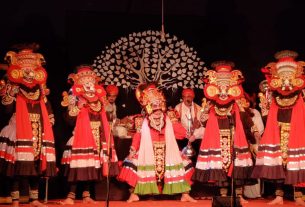Despite India’s digital revolution, digitising art and culture continue to take a backseat for several reasons.
A Museum of Art and Photography (MAP) report states that digitising art and culture in India continues to face basic challenges like funding and infrastructure. Experts, however, say that a lack of interest might also be a big problem.
Abhishek Banerjee is the co-founder and conservator at the Bengaluru-based art conservation studio, Museocollective. Among other projects, he has worked as a Conservation Consultant for the archives at National Centre for Biological Sciences (NCBS).
With years of experience in digitising art, he said, “We use an overhead scanner to scan and digitise the pieces, which can cost over Rs. 3,00,000. The only alternative can be a Digital Single-Lense Reflex (DSLR) camera, a decent one of which is again somewhere between Rs. 45,000 to Rs. 50,000.”
However, in terms of infrastructure, there are some other challenges as well. Some art pieces are literally ‘oversized’’for overhead scanners, and the scanners can’t digitise them. An overhead scanner can only scan and digitise slightly bigger than A3 documents, any larger than that, needs a DSLR camera.
“It’s very important to digitise art, even for the smaller, more remote institutions. Everything decays after a point, and digitising them is the only way to avoid losing culture and heritage,” said Abhishek.
However, Dr. Sudakhshina Mukherjee, Faculty, Dept of Museology, Rabindra Bharati University, Kolkata, said, “For major institutions, it’s not a question of funding; it’s not a question of lack of expertise. Both can be garnered, but what is important is motivation of museum authority.”
“India has a five thousand year old civilization which is rich in material heritage which has been made the responsibility of the Indian museums. But the directories of these museums are very ill-maintained,” she said.
Due to ill-maintenance of the directories, if an item goes missing, they become untraceable, which is why digitising them is very important. “Around 2013, because of this reason, the government of India had directed all information regarding museum collections to be digitised. Despite this, most of the museums have not taken cognisance of this direction.”
Different institutions, different problems
Dr. Mukherjee explained that the JATAN software developed by the Centre for Development of Advanced Computing (C-DAC) to digitise artefacts centrally is not expensive software at all, and the process runs very smoothly.
She continued, “For big, especially government institutions, funding is not the problem at all. One-time setup expenditure for a scanner, a supercomputer and other linked computers is nothing for central museums. But the museums give excuses like lack of funds when the procedure is actually inexpensive; lack of directions, when C-DAC trains museum personnel themselves.”
A JATAN operator from the Indian Museum, Kolkata said that C-DAC has individual teams for all of the 10 national museums. “If we face any snag, we simply call the team leader and they help us solve the issue almost immediately.”
The Indian Museum, the largest museum in Asia, started its digitisation work in late 2013, and as of 2023, has digitised and uploaded 62 percent of its collections. “We have over one lakh objects at Indian Museum. Some of the smaller ones, like coins, take around two to three minutes to process for digitisation; while the larger ones with more details may take up to three to four days,” he said.
He further said that when the JATAN project was initially launched, navigating around it was difficult. “Nothing like this had ever been done in the national museums before, so at first, progress was slow. But now, each month we at the Indian Museum, process more than one thousand objects for digitisation.”
He explained that since JATAN is a server, its smooth functioning depends on a lot of factors. Some of these are its configuration, modification, language, different levels, type of Internet, technology and so on. “JATAN work goes on four different levels, so training personnel for the different levels differently was initially a tough task.”
However, for smaller institutions, funding is generally an issue as they don’t take the initiative to digitize the art. “Having either (a scanner or a DSLR) is difficult, let alone having both. However, outsourcing the digitisation work, again, can become very expensive, as well,” said Dr. Mukherjee.
Abhishek said that many galleries have excellent collections but not enough funding for this type of work.
Abhishek added, “For a professional photographer to come and make digital copies of entire collections multiple times is always going to be expensive. Same goes with outsourcing work to private companies that have access to overhead scanners.”
The National Gallery of Modern Art (NGMA), Bengaluru, outsource all of their digitisation work, said an official working there. “We bring in photographers in the gallery for items such as miniature artefacts. But for the larger artefacts, since we don’t have a scanner, we send them to NGMA, New Delhi. It is the headquarters, so they have all the equipment.”
Travel time included, it takes around three to four months to digitise a standard collection. Currently, NGMA, Bengaluru has 530 permanent collections of various artists. “We have to digitise every single item in each of the 530 collections according to the directives by the government of India.”
Grants: a long wait
Abhishek said that funding does not necessarily have to be a problem. “Sometimes institutes simply don’t look in the right places, or funds are just stuck in the pipeline.”
He explained that people are not aware about grants, private or government, which could help with funding. “There are actually many grants even by the government which are renewed every year. The India Foundation for the Arts, for example, has done massive work for decades in terms of grants.”
People are either not aware of the grants themselves, or are not aware of how to access them. And in some cases, the waiting period can be lengthy and the criteria specific, so many others don’t end up applying.
Typically, it takes around six to nine months for an application process to be completed. “For example, if the Alkazi Foundation has an opening around April, they’ll start announcing it since November, the previous year. Then, the application screening process takes up another three months or so,” said Abhishek.
The government of India initiative to digitise museums began in 2013. Through the JATAN software, only some of the central government museums have been digitised and added to the National Digital Repository. Some of these museums are the National Museum, New Delhi, the Indian Museum, Kolkata, the National Gallery of Modern Art in New Delhi, Mumbai, and Bengaluru, etc.
However, for museums under state governments, NGOs, small private groups, and so on, the process continues to be a struggle.





Very well analyzed and reported.
Amazing coverage